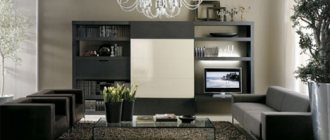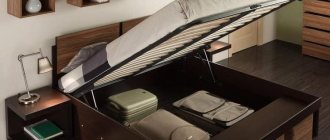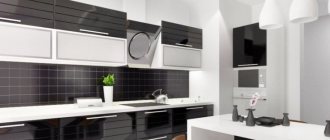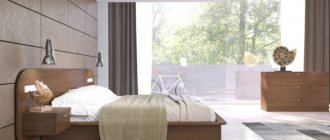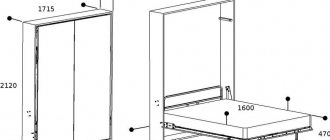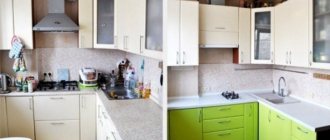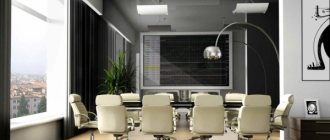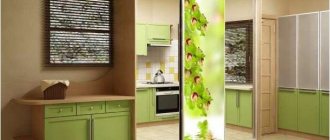What is contraindicated to use for caring for kitchen furniture?
Housewives daily struggle in the kitchen with grease, limescale, soot, and dust.
Dust is not the only enemy of cleanliness in the kitchen.
To remove stains from the surface of furniture made of any materials, it is not recommended to use:
- Cleaning agents (soda, powder, solvent, alkali, acid) that corrode the coating.
- Hard scrapers, scourers with metal fibers that scratch the surface, making it dull and accessible to further contamination.
Use quality cleaning products.
The correct approach to processing the coating determines the safety of the set. It is necessary to choose detergents depending on the characteristics of the material from which the surface to be treated is made.
Each material in furniture requires a special approach.
Before use, check its effect by dropping the substance onto an inconspicuous area.
Caring for furniture made of MDF and chipboard
Furniture from a variety of artificial materials is created specifically in order to find the ideal balance between the long service life of the product and the affordability of its purchase. In pursuit of durability and durability, many interesting innovations have been created, of which the most popular materials today are laminated chipboards and MDF boards. Let's look at their advantages:
- cleaning with almost any detergent, including strong chemical compounds;
- no traces of abrasion or deformation;
- moisture-repellent properties;
- easy care of MDF kitchen furniture.
All useful tips for caring for MDF furniture boil down to the fact that such things should be protected from scratches. Be careful when using hard wire jaws, scrapers, or similar tools. Otherwise, your choice of cleaning accessories is unlimited. If you have such a convenient set as furniture made of MDF or a kitchen made of chipboard, you can extend the life of the product by constantly monitoring the condition of the fittings and roller mechanisms for pulling out drawers.
Rules for caring for kitchen furniture depending on its coating
It is necessary to transport furniture very carefully so as not to damage the coating (scratches, chips), which are very difficult and sometimes almost impossible to get rid of.
Involve children in cleaning the kitchen.
The functionality and service life of the kitchen depends on compliance with the following general rules:
- room temperature (from +10 to + 25 degrees);
- the humidity in the room should be within normal limits;
- presence of good ventilation;
- exclude exposure to steam, high temperatures, and mechanical damage to the surface.
Caring for kitchen furniture begins with its proper placement.
If these conditions are violated, deformation, swelling, and delamination of the surface of the kitchen furniture are possible. To preserve the beauty of texture and color, an individual approach and optimal methods of caring for the coating are needed.
Don't forget to clean the upholstered chairs in the kitchen.
Natural wood
Furniture made from natural wood is unique, captivating in its beauty and requires special care. How to properly care for wooden furniture in the kitchen and maintain its original appearance?
You need to wipe dust from wood products along the lines of the natural pattern, removing dirt from the coating. Wood can absorb moisture, changing color and deforming. To avoid this, if necessary, you need to ventilate the room in the summer, use a humidifier in the winter, eliminating direct sunlight on the headset.
There are special cleaning products for wood.
The wooden facade is coated with a special wax, so cleaning the surface with washable vacuum cleaners or steam generators is not recommended and must be wiped with a dry cloth after wet cleaning.
For a glossy surface, soft fabrics must be used.
For care, use soft cloth or suede and detergents containing wax, silicone, and oils. Fresh stains must be removed immediately with a napkin to prevent them from becoming embedded in the wood.
MDF
Let's look at the rules for caring for kitchen sets made of MDF (fibreboard), which are affordable. This material has a number of advantages (environmentally safe, practical, durable); furniture facades are made from it.
Chipboard and MDF, in fact, are also made from natural materials.
Matte facades can be washed and wiped with various detergents, except for those containing chlorine, which leave scratches and deteriorate the appearance and color. Polishes and waxes are prohibited. Caring for furniture made of MDF with a glossy finish has its own characteristics.
MDF is very sensitive to temperature,
For cleaning it is necessary to use a soft material, polish, window cleaner, wet wipes (not containing alcohol), warm water and wipe the surface dry after finishing the treatment. After removing the protective film from the surface, it is advisable not to clean it for a month.
To clean wooden facades, use a cloth soaked in water.
Long-term exposure to water, high humidity, and the use of a steam cleaner causes film peeling, swelling, bloating and a shortened service life of furniture, so it is not recommended to use them.
In some cases, you should call a professional who will replace kitchen parts.
Veneer
Veneered furniture has an attractive appearance, like natural wood. In its production, slabs of shavings are used with solid wood glued on them and varnished at the top. You need to look after her very carefully.
Just periodically wipe the dust off the veneer with a soft cloth.
Some tips will help keep your headset in shiny condition:
- installation of furniture should be carried out away from heating devices (fireplace, radiators) so that delamination and deformation do not occur;
- avoid the appearance of dried, old stains;
- to add gloss and shine, use polishes (silicone - protection from moisture, wax - from dust, oil allows you to hide small scratches);
- Do wet cleaning with a soft cloth soaked in a soapy solution, moving along the fibers, wiping the glossy surface dry (removing stains).
To clean stubborn stains, there are special furniture care products.
Other types
A modern and simple solution combined with exclusivity are kitchens with aluminum facades, made in the color of wood, metal or other shades. The matte surface looks original, suitable for classic and modern styles.
Abrasive powders and soda are not suitable for cleaning furniture made of any materials.
It has the advantages:
- resistant to external factors (humidity, scratches, shocks are not afraid of it);
- durability, appearance practically does not change over time;
- possibility of combination with other materials (wood, MDF);
- reasonable price;
- does not require special care.
Use all household appliances that can remove dust.
How to care for a white kitchen set?
- home
- News
- How to care for a white kitchen set?
22.08.2019
White kitchen sets have always been and will be popular. They look stylish, bright, original, and will charge you with positive energy and a great mood. White color is universal - you can easily match it with any additional interior details of any color and style.
But many avoid buying white kitchen sets, considering them to get dirty quickly and impractical. This is wrong. On a white background, dust, water drops, fingerprints, and other types of dirt will not be as noticeable as, for example, on a black or gray background.
It is believed that having purchased a white kitchen set, you will have to spend a lot of time cleaning it. In fact, you need to take care of any kitchen set, because if traces of dirt are not visible, it does not mean that they are not there. If you take care of it correctly and on time, the service life of the kitchen will increase significantly.
Is it more practical to choose glossy or matte facades for a kitchen set? On a glossy facade, fingerprints are more visible; on a matte facade, on the contrary, ordinary dirt and water splashes are more noticeable.
For the kitchen, it is better to use materials that are easy to clean. For walls, choose washable wallpaper or plaster; for floors, choose tiles or moisture-resistant laminate.
Basic tips for caring for a white kitchen If splashes of water or dirt come into contact, wipe them up immediately. It's easier to do this while they're still wet. And on some surfaces, yellow spots may subsequently appear in place of ingrained dirt. Do not use cleaning agents or abrasive sponges that will scratch the surface of the product. This especially applies to glossy facades.
Use a hood when cooking - this way you will avoid fat particles settling on white surfaces. Fat leaves a yellow coating on the surface, which is then difficult to remove.
To prevent white facades from fading or turning yellow, avoid prolonged exposure to sunlight - use blinds and curtains. Usually, to get rid of such yellowness, use 1 tbsp. tea soda, 1 glass of vinegar solution and 2 glasses of warm water.
Be sure to wash white surfaces at least once a month with warm water and a special cleaner.
If the kitchen has a white floor, be sure to vacuum it before wet cleaning so as not to rub dirt into it.
And in our catalog you will find a kitchen to your liking, as well as any kitchen presented on our website, you can order white in a glossy or matte finish.
Comments
No comments yet
Traditional methods of caring for kitchen furniture
Effective folk remedies for caring for kitchen units are the following methods:
- dilute vodka or alcohol with water in a 1:1 ratio;
- Dilute ammonia (1 tbsp) in water (1 liter).
Use different products to achieve cleanliness in the kitchen.
These products can leave streaks on a glossy surface; they must be used carefully. A safe, non-harmful method is to use a solution of a little lemon juice, vinegar and alcohol to remove grease from the white coating.
During wet cleaning, you can wipe all surfaces with vinegar. To do this, mix 5 liters of water with two tablespoons of this product.
A liquid made from apple cider vinegar mixed with vodka is suitable for regular use and will leave your kitchen sparkling clean. Soap diluted in warm water is the easiest way, which is always at hand.
Distribute the weight in the cabinets evenly so that the sliding parts do not lose balance.
All the recommendations listed above will help you avoid problems in caring for furniture and will make your stay in the kitchen area comfortable.
With proper care, an Italian kitchen will serve you for decades.
Kitchen care
Kitchen furniture to order from the manufacturer, children's furniture, wardrobes. PKF South Wind Unfortunately, no one is immune from accidental contamination of furniture and other similar troubles. Don't be upset and stop counting money! You just need to know and be able to properly care for furniture and remove dirt in a timely manner. After all, how nice it is to come home from work and plunge into the kind and cozy atmosphere of the family hearth...
Caring for wooden surfaces Wooden surfaces (including those covered with natural veneer). It should be remembered that all wooden surfaces of kitchen furniture can change appearance over time, not only depending on climatic characteristics and environmental conditions, but also on how the owner cared for them. In addition to general care conditions, it is recommended to use a soft cloth or suede for cleaning, dampened and wrung out well before use. Always thoroughly dry (wipe with a dry cloth) the wetted areas after cleaning. A good alternative is systematic dry cleaning of kitchen furniture using a vacuum cleaner equipped with a soft brush attachment. The use of wood polishes is recommended. At the same time, polishes (other household chemical products) that have contraindications for contact with food products should not be used to polish kitchen furniture. The use of hard devices (scrapers, sponges with a working coating made of plastic or metal fiber-like material) when cleaning is strictly prohibited.
Care of varnished surfaces Lacquered surfaces. All lacquered surfaces of kitchen furniture can change color over time, not only depending on climatic characteristics and environmental conditions, the nature of care, but also depending on the degree of exposure to light. It is recommended to use a dry soft cloth or chamois for cleaning, using cleaners specifically designed for this purpose, which often contain polishing agents. It is possible to use polishes for varnished furniture surfaces, which, as a rule, also have cleaning properties. At the same time, polishes (other household chemical products) that have contraindications for product contacts should not be used for polishing (cleaning) kitchen furniture. The use of hard devices (scrapers, sponges with a working coating made of plastic or metal fiber-like material) when cleaning is strictly prohibited. Caring for laminate flooring Laminate surface. In addition to general care conditions, it is possible to use polishes for plastics. At the same time, for polishing (processing) kitchen furniture, you cannot use polishes (other household chemical products) that have contraindications for contact with food; carefully read their instructions! Avoid using hard tools (scrapers, sponges coated with plastic or metal fiber-like material) when cleaning. Care for laminate and melamine coated surfaces. Panel surfaces treated with melamine resins are resistant to common chemical substances (solvents, alcohol-containing liquids, ink, coffee, wine, etc.). They demonstrate a high degree of resistance to scratches and abrasions, and practically do not react to exposure to sunlight. Almost any spray liquid can be used to care for the countertop, with the exception of materials that have an abrasive principle of action. If there are no special cleaning products, it is enough to wipe the surface with a damp cloth and then wipe the table dry.
Caring for granite and marble Surfaces made of granite and marble. These are “living” materials, so a feature of such surfaces is their high hygroscopicity (tendency to absorb liquids). Because of this, there is a danger of streaks and permanent stains. In addition to the general conditions for caring for kitchen furniture (see other articles), it is recommended to use a denatured alcohol solution if degreasing is necessary. Protect surfaces from time to time by applying special water-repellent products for marble and granite. After applying such products and before using them again, wipe them thoroughly with a soft, dry cloth. Always dry wet areas thoroughly after cleaning.
Caring for metal surfaces Metal surfaces (including chrome and glossy). Do not use products that have abrasive or corrosive properties, or sponges coated with metal fibers or flakes when cleaning. After cleaning, the surface will be given a spectacular shine by polishing it with a soft, dry cloth using a reciprocating motion. Caring for metal parts of furniture. Metal parts are treated mainly with epoxy paints by spraying or high-performance galvanic coating. In any case, the strength of the coating is comparable to the strength of the metal itself. No special products are required to clean metal parts. Having previously removed dust from the surface, simply wipe it with a damp cloth. Do not use products that have abrasive or corrosive properties, or sponges coated with metal fibers or flakes when cleaning. After cleaning, polishing with a soft dry cloth using a reciprocating motion will give the surface a spectacular shine. Caring for ceramics Ceramic surfaces. Ceramics (faience, porcelain) are fragile materials: do not drag heavy hard objects over the surfaces. In addition to general care conditions, it is recommended, if degreasing is necessary, to use an aqueous solution of denatured alcohol. Can be cleaned using glass cleaner.
Caring for glass surfaces Glass surfaces. These are very fragile surfaces (except for specially tempered glass), so be careful when handling heavy, hard objects. For cleaning, use special glass cleaners. Do not use products with abrasive properties, or sponges coated with metal fiber-like or chip-like material when cleaning. Caring for glass sinks It is necessary to completely avoid cleaning powders and rough cleaning sponges, otherwise scratches cannot be avoided. The frequency of cleaning is up to you. In any case, caring for a glass sink is not much more difficult than caring for a regular ceramic sink. Several times a month you need to use a window cleaner, which any housewife can find.
What are the advantages of using glass sinks compared to ceramic ones? Take a look at glass vanities with countertops. So many washing or shaving items can be placed on such a large flat surface. Ceramic sinks do not provide this opportunity. However, the best thing about glass sinks is their amazing variety. All sorts of colors, patterns, shapes, placement and much more - that's the advantage of glass sinks. Where have you seen a ceramic sink in the shape of a flower or the petal of a tropical plant? In the range of glass sinks you will find all sorts of colors and configurations to suit every taste. The shine of the glass surface does not fade over time, so for a long time your glass sink will look like it was just purchased. Manufacturers of glass sinks create seamless combinations using various shelves, bedside tables, and countertops made of the same glass. You don’t have to look for or order any furniture and install your favorite glass sink into it. This has already been done, you just need to choose the option that suits you and fits the size of your bathroom. In a word, by choosing a glass sink in a set with appropriate furniture, you will make the right choice, which will make it easier for you to arrange your bathroom. High quality, durability, elegance and basic care are the main advantages. Caring for upholstered furniture To extend the life and maintain the newness of upholstered furniture, you need to follow a few basic rules of regular care. First of all, it is necessary to regularly clean it with a vacuum cleaner to remove dust and maintain the silky shine of the covering material. Secondly, you should pay attention to the purchased furniture and try to avoid mechanical damage, breaks in the fastening material, and rupture of the covering material. Periodically, as it becomes dirty (but at least once a month), it is necessary to clean upholstered furniture from dust. And if you can simply wipe leather furniture with a damp cloth, then in the case of fabric upholstery everything is a little more complicated. Furniture upholstered with fabric should not be wetted too much and at the same time just knocking it out is also not an option, a cloud of dust will rise, which will settle anyway. In such cases, a method not known to everyone is recommended: before knocking out the dust, cover the furniture with a damp sheet. And if you moisten the sheet not with ordinary water, but with a light vinegar solution, the colors on the upholstery will become brighter. When cleaning (including leather upholstered furniture), special attention should be paid to the seams; it is in these places that the most dust usually collects. Spilled liquids should be immediately removed from the surface of the material, preventing them from spreading and penetrating into the base of the fabric or pile!
To remove stains from furniture upholstered in chinille, velor or other fabric, you should make a weak solution of soapy water and prepare a soft brush. Gently moisten the contaminated area with the prepared solution using a brush. The most important thing is not to overdo it with the amount of water! Do not generously water a chair or bed with soapy water; just wet the brush and gently brush the desired area. From the abundance of water, the fabric can become streaky! After cleaning, the wet stain should be dried and combed with a soft brush in order to restore the crumpled pile and give the furniture its original appearance. Stains left by tea and coffee are best removed with a solution of vinegar and detergent. It is best to “remove” beer stains with the same soap solution, but for subsequent treatment and odor removal, you should treat the surface of the stain with a weak solution of vinegar - approximately 2-3 tablespoons of white vinegar per liter of water. Stains on the leather surface should be removed with a soft, damp cloth. Do not use alcohol, acetone or soap - these substances are not suitable for leather upholstery of a chair or sofa. To maintain the excellent appearance and shine of your furniture, you should treat its surface several times a year with a special leather cleaner. Also, when drying such furniture, under no circumstances should you use a hairdryer or vacuum cleaner; simply wipe with a soft, fluffy cloth. With such care, it will not be difficult to extend the life of the beauty of your home and preserve the comfort and style of the abode for a long time.
Aggressive environments and abrasive materials. Aggressive environments and abrasive materials.
Under no circumstances should furniture products be exposed to aggressive liquids (acids, alkalis, oils, solvents, etc.), products containing such liquids or their vapors. It is also worth remembering that some specific detergent (cleaning) compositions may contain a high concentration of aggressive chemicals and/or abrasive compounds. To remove stains, you should use domestic or imported furniture cleaning products (shampoos) in accordance with the instructions for use. The use of foam cleaners is recommended. Grease and ink stains should also be removed with specialized furniture shampoos. Remember that the main thing is to treat your furniture with care, and then you will need a minimum of care products, your furniture will always look like new! Source: www.wind-south.ru - PKF "South Wind" - kitchen furniture from the manufacturer. order products and get background information by calling us at tel. +7 916 588-17-23 from 9ºº - 21ºº, or by e-mail: [email protected]
Rules and conditions for the use of furniture
Rules and conditions for the effective and safe use of furniture (GOST R16371-93, GOST R19917-93).
We thank you for purchasing the furniture and sincerely hope that it will give you only pleasure for a long time. However, in order to avoid problems that could overshadow the joy of your purchase, we kindly ask you to take note of this Consumer Information and follow its recommendations.
When choosing a product, exercise caution regarding the size, style, shape and other similar qualities of furniture, since the right to exchange goods of proper quality, provided for in Art. 25 of the Law of the Russian Federation “On the Protection of Consumer Rights” dated 02/07/92 2300-1, in accordance with the Decree of the Government of the Russian Federation dated 01/19/98 No. 55 does not apply to furniture.
Warnings and Recommendations.
- Make sure that your new kitchen set is undamaged and fully equipped. All technological openings on top must have good waterproofing.
- Your furniture and equipment must be installed by qualified personnel in strict accordance with the Manufacturer's recommendations. Incorrect installation can cause harm to people, animals, and your property. In this case, the Manufacturer declines all responsibility.
- Electrical safety is guaranteed only if there is an effective grounding in accordance with electrical safety regulations. Make sure that all power outlets in the room have grounding devices and are properly grounded. In the absence of effective grounding, the Manufacturer declines all liability for possible damage.
- A service center specialist connecting electrical equipment must check that the cross-section of the wires corresponds to the current consumed by the equipment. All electrical wiring must comply with the requirements set for it, so trust the replacement of wiring only to licensed specialists.
- It is not recommended to use adapters or extensions. If you consider their use necessary, use only one extension cord that meets safety requirements. Do not exceed the wattage rating marked on the extension cord or wall outlet, as this may result in a fire.
- Do not leave equipment turned on unless necessary. If you are away from home for a long time, be sure to turn off all electrical equipment and shut off the water and gas supplies.
- It is allowed to use backlighting with halogen bulbs with a power of no more than 20w in the absence of foreign objects at a distance of up to 20 cm from the nearest light source, due to their possible heating and spontaneous combustion. To replace halogen light bulbs in the backlight, you need to disconnect the transformer supplying it from the network and, without touching the light bulb itself with your hands or any greasy objects, insert it in place of the burnt out one.
- Make sure that ventilation holes and cracks are not blocked. If this happens, there is a danger of exceeding the operating temperature of the electrical insulation and causing a short circuit. This applies not only to electrical equipment, but also to the ventilation system of floor cabinets. No foreign objects should be stored under the cabinets behind the plinth, where all the wiring runs.
- All built-in equipment and other devices used in this room must be used strictly for their intended purpose and in full accordance with the operating instructions. If you decide to use, for example: 1) an oven or stove for heating; 2) a refrigerator for cooling the room; 3) kitchen furniture for chopping frozen foods; etc., then do it at your own peril and risk. The manufacturer is not responsible for damage or defects caused by improper, incorrect or unreasonable use.
- In case of malfunctions and/or incorrect operation of any equipment, turn it off and call a service center specialist, gas service or utility employee. Do not use faulty equipment, and especially do not try to repair it yourself.
- Some appliances in the kitchen can become very hot during the heat treatment process. Warn your children or simply do not let them into the kitchen because many other dangerous objects are also used for cooking (knives, matches, household chemicals, etc.), and you may not notice in time their careless use by children.
- Keep hair, loose clothing, fingers and other parts of the body a safe distance from the stove, oven, waste disposer and other hazardous household appliances
- If your stove or hob has a large burner located against the wall, during long-term cooking, especially if the diameter of the pots and pans is large, the wall plinth (edge) and wall panel may become deformed from the high temperature.
Climatic characteristics and environmental conditions.
It is very important to understand how climatic characteristics and environmental conditions can affect the appearance and quality characteristics of furniture. Since furniture products are sensitive to light, humidity, dryness, heat and cold, it is recommended to avoid prolonged exposure to one or more of these conditions, as this causes accelerated aging of the paintwork, warping and deformation of wooden furniture elements, and aging of the upholstery material.
- Light
Avoid direct exposure of furniture to sunlight.
Prolonged direct exposure of some areas to light can cause their chromatic characteristics to decrease compared to other areas that have been less exposed to radiation. If components are replaced and/or added at different times, color differences may occur between the elements that make up the furniture. This difference, which will become less noticeable over time, is completely natural and therefore cannot be considered a sign of low quality furniture.
- Temperature
High levels of heat or cold, as well as sudden changes in temperature, can seriously damage the furniture product or its parts. Furniture products should not be located less than 1 m from heat sources. Furniture should be used in dry and warm rooms with heating and ventilation at an air temperature not lower than +10º C and not higher than +40º C. Significant deviations from these conditions lead to a significant deterioration in the consumer qualities of the furniture, as well as deformation of the elements that make up the furniture. Recommended air temperature during storage and/or operation is + 10°C – +25°C.
Do not expose furniture to hot objects (irons, dishes with boiling water, etc.) or prolonged exposure to radiation that causes heating (light from powerful lamps, unshielded microwave emitters, etc.). It is not allowed to place hot objects on the furniture surface without heat-insulating supports.
- Humidity
The recommended relative humidity of the location of the furniture product is 60% -70%. You should not maintain conditions of extreme humidity or dryness in the room for a long time, much less change them periodically. Over time, such conditions can affect the integrity of furniture products or their components. However, if you have created such conditions, it is recommended to frequently ventilate the premises and, whenever possible, use dehumidifiers or humidifiers to normalize humidity
To avoid swelling of the boards and peeling of the plastic or film, do not allow direct exposure to steam (electric kettle, electric steamer, etc.) and the accumulation of water on the surface of furniture products. Sections with wooden and glass shelves are designed for storing dry dishes and kitchen utensils. Special sections with metal shelves and a tray attached to the bottom are designed for storing wet dishes.
- Physical exercise
The surfaces of furniture and its structural elements should be protected from mechanical damage that can be caused by exposure to hard objects, abrasive powders, and excessive physical stress.
When using furniture products, do not use excessive force to open doors, drawers or other moving parts.
Try to load kitchen drawers and kitchen drawers evenly, ensuring the sliding parts are balanced. It is recommended to place items on the shelves according to the principle: the heaviest ones are closer to the edges (walls of the box), the lighter ones are closer to the center. Remember that the static vertical load for kitchen drawers made of chipboard is not more than 5 kg, on the bottom of metal boxes (metabox) - more than 18 kg, (tandembox) - more than 35 kg; on shelves (cabinets, racks) – more than 8 kg.
- Aggressive environments and abrasive materials
Under no circumstances should furniture products be exposed to aggressive liquids (acids, alkalis, oils, solvents, etc.), products containing such liquids or their vapors. Such substances and compounds are chemically active - a reaction with them will have negative consequences for your property or even health.
It is also worth remembering that some specific detergent (cleaning) compositions may contain a high concentration of aggressive chemicals and/or abrasive compounds. The use of such detergents is unacceptable!
To clean the sink and faucet, use special cleaning products recommended for this surface and do not contain abrasive materials.
To avoid damage to the coating of furniture fittings, food acids should be stored in closed containers.
Kitchen furniture care
Cabinets
To clean laminated kitchen cabinets, shelves and drawers, use a slightly damp cloth and liquid detergent.
After cleaning, always wipe the surface dry with a soft cloth!!! If you use a cloth that is too damp when cleaning, water may seep into the cracks and cause the wood to swell. Do not use any aggressive or corrosive products, various polishes, wax polishing paste, hard sponges or steam cleaners. To remove heavy stains (old grease residues, shoe polish, felt-tip pen marks and similar stains), you can use glass cleaners. Before use, always test the detergent on an inconspicuous area of the surface!!!
Pens
Handles and rounded door handles can be cleaned using a soft cloth and household detergents without abrasives, without acids, without alkalis, without solvents.
Furniture facades
Furniture facades have a decorative function. In accordance with European standards, the appearance of products is assessed visually under normal conditions from a distance of at least 60 cm and an inspection angle close to 90° to the surface of the product.
- Lacquered facades
Lacquered and glossy surfaces of facades are cleaned with special rags made from materials with an antistatic effect, designed for the care of glossy surfaces. For severe contamination, use liquid cleaning solutions with a neutral pH of 6-8.
- Facades coated with PVC film, laminate.
Neutral (pH 6-8) and slightly alkaline detergents are suitable for cleaning facades coated with PVC film, as well as laminate. Surfaces treated with an alkaline solution must be wiped with a damp cloth. Chemical resistance to stains from exposure to: acetic acid (10% solution), coffee and tea (t 80°C), red wine, ethyl alcohol, olive oil.
- Veneer-coated facades, solid wood facades.
Facades made of solid wood and covered with veneer can be periodically treated with special care products for natural wooden surfaces containing palm or paraffin oil and wax. Thus, the properties of the wooden surface are improved, its service life is extended and its maintenance is simplified. Do not wash with copious amounts of water, as... the wooden surface may swell and peel off from the main part. Surfaces can be cleaned with a slightly damp cloth soaked in a solution of neutral liquid soap. After wet treatment, you must immediately wipe dry.
Solid wood facades, as well as those covered with veneer, are exposed to sunlight, including direct rays from light sources. As a result, a change in color saturation is possible (slight darkening of the varnish used to treat facades). The change in shade and “depth” of color is especially noticeable on facades made from “red” wood. Facades made using valuable root veneers may undergo natural aging with the formation of “veins”.
- Glass facades in profile or frame, stained glass windows
Glass doors and stained glass windows are cleaned with window cleaner and a cloth designed for this purpose.
When replacing facades coated with dye, varnish or enamel, it is necessary to take into account that each set of furniture is coated with individually prepared dye, varnish or enamel, which, in turn, is tinted according to an approved sample. However, the color of each batch of dye or enamel is unique and cannot be 100% identical to the approved sample. It is also necessary to take into account that a new part always differs from a used one in terms of gloss, color saturation and transparency. This is due to exposure to UV rays. This difference is leveled out over time.
Caring for a plastic tabletop
The tabletop is one of the most important working elements of furniture.
Tabletops should be used in dry, ventilated rooms with temperatures from +10°C to +40°C without sudden temperature changes.
Unlike other furniture elements, the tabletop has higher properties:
– to abrasion and scratching
– to exposure to high temperatures
- to blows
– to exposure to chemicals
– to exposure to moisture
- To maintain the appearance of the countertop, you should adhere to the following rules:
1.1.Use a cutting board to avoid leaving scratches or dents on the countertop surface.
1.2. Immediately remove spilled water from the surface and from the joining seams of the tabletop.
1.3. Do not place hot objects on the countertop without a thermal insulation pad.
1.4. Wipe the countertop only with a napkin, soft sponge or cloth.
2. Surface cleaning.
2.1. Remove stains as soon as they appear.
2.2. For cleaning, use ordinary cleaning products that do not contain abrasive (abrasive) materials or strong solvents. Read the instructions for the cleaning product you are using before cleaning your countertop.
Do not use furniture polishes containing fat, oil, or wax, as they clog the surface of the countertop and form a film that accumulates dirt.
- Prohibited:
3.1. Exposure of the surface of the countertop to highly heated objects with a temperature above 180 ºС, and on the drip tray and edged ends of the tabletop - above 140 ºС.
3.2. Exposure of the countertop to water steam, cold and hot water for more than 5 minutes.
3.3. Exposure to aggressive liquids - acids, alkalis, oils, solvents, paints, salts.
3.4. Mechanical impact on the surface and ends of the tabletop. Using sharp, cutting or abrasive objects when working or cleaning the countertop.
- Exploitation.
4.1. It is unacceptable to use products based on chipboard coated with decorative plastic if the product or its individual surfaces are exposed to mechanical, thermal, chemical effects, steam or water, dyes, aggressive environments, etc., as a result of which defects appear at the points of exposure. Complaints related to improper operation will not be accepted for consideration.
Caring for countertops made of natural and artificial stone
1.For everyday care of products made of natural and artificial stone, use non-abrasive liquid soap and a soft brush, after use, rinse the surface with clean water. For old or difficult to remove stains, apply one of the non-abrasive household cleaners to the surface and leave for no more than 10 minutes, then rinse the surface with water and wipe it with a dry cloth.
2.Do not use strong alkaline agents, oven or grill cleaners, cleaners with a pH level higher than 10, or concentrated cleaners containing chlorine to clean stone surfaces.
3.Do not install natural or artificial stone products outdoors or in any place where exposure to ultraviolet rays is possible.
4.Do not forcefully hit the stone surface or sides of the product with hard objects.
5.Do not use the countertop surface as a cutting board.
6.Do not place hot baking sheets, frying pans, or pots that have been removed from the fire directly on the surface made of natural and artificial stone. Use stands. Do not move dishes with metal bottoms across the countertop.
7.Do not use steel wool.
8. Products made of natural and artificial stone must not be heated above 90 0 C.
Prevention
After a certain period of use, it may happen that some mechanical parts (hinges, guides, opening mechanisms, etc.) lose the optimal adjustment and lubrication performed during the assembly of the furniture product. Such phenomena can be expressed in creaking, difficulty in drawing out drawers, transformation mechanisms, etc. Their proper operation is ensured by timely adjustment of the hinges or lubrication of the guides with paraffin or a similar product. When loosening threaded connections, they must be tightened periodically, being careful, because additional force on components and connections can lead to their destruction. By following the requirements and recommendations of this manual, you will be able to always keep all the elements of your furniture in the best condition.
Warranty
The seller provides a guarantee for the goods sold for 24 months from the date of transfer of the goods to the buyer, provided that the consumer complies with the conditions of transportation, storage, assembly and rules for operating the furniture. Furniture defects identified during the warranty period, with the exception of those that arose through no fault of the seller (for example, in the event of a violation by the buyer of the rules for using furniture products) or about which the buyer was warned in advance, before the delivery of the furniture, will be eliminated free of charge. During the warranty period, the seller undertakes to repair or replace defective parts of the product within an objectively feasible minimum period after the buyer discovers a defect. Warranty service is provided only if there is a document confirming the purchase of the furniture product in our furniture store.
The use of furniture is considered incorrect if there are sufficient grounds to assert that the furniture or its individual surfaces were subjected to mechanical, thermal effects, water or steam, exposure to aggressive agents or dyes, etc., as a result of which damage appeared at the points of impact (swelling, scratches) , chips, etc.).
The warranty period for tables, chairs, dining rooms, built-in appliances, faucets, sinks, sanitary ware, as well as warranty service conditions are established by the manufacturer. Warranty repairs are carried out at the manufacturer’s specialized service centers indicated in the warranty cards.
Warranty obligations do not apply to “consumable” components (lamps, filters, etc.). Failure to comply with the above conditions and recommendations, resulting in defects in the furniture product, is grounds for loss of the right to warranty service.
The seller also provides an additional guarantee for the installation of furniture for 3 months from the date of assembly. During this period, our specialists will free of charge eliminate installation defects identified during operation (misadjustment of hinges/facades; incorrect operation of opening mechanisms, etc.), except in cases where the operation of the furniture is considered incorrect - in this case, the buyer must pay for the visit and work seller specialists.
Please remember that warranty service is not provided in cases:
- In case of violation of storage and independent transportation conditions.
- In case of independent unqualified assembly of products.
- In case of use of products other than for their intended purpose.
- In case of independent changes in the design of products.
- In case of improper use of products and violation of the conditions of care and operation of kitchen furniture, built-in appliances, as well as other household appliances used in conjunction with the furniture and appliances you ordered.
- Incorrect use of transformation, extension and opening-closing mechanisms.
- When the maximum load established for a given type of mechanism and product is exceeded.
- On glass mirrors and stained glass (detection of cracks on glass and stained glass after furniture has been accepted).
- Loss of the contract, payment documents and this application.
- Repair of furniture and equipment by unauthorized persons, its disassembly and other interventions not provided for in the instructions.
- Damage to the product or its loss due to force majeure circumstances: (natural disasters, fire, flood, accidents, etc.).
- Mechanical damage, exposure to water or steam, traces of exposure to chemicals and improper use of consumables.
- Damage caused by extreme climatic conditions during transportation, storage and operation.
- Damage or malfunction of household appliances caused by animals or insects.
- Connecting household appliances to the network with invalid parameters.
- Using products for purposes for which they are not intended, including for production purposes.
- Making corrections to the text of the agreement and its annexes.
- Blocking of moving elements of products when foreign objects and small parts of clothing enter the internal working volumes.
- Failure to comply with installation and connection rules, as well as in the case of poorly executed or damaged waterproofing of products.
- Negligent storage and/or transportation by the owner by a third-party transport, trade or service organization (in these cases, the owner should file claims with the organizations that carried out the transportation and storage).
- Overheating-deformation of the wall plinth (edging) and wall panel in the area of the gas stove or hob.
- Failure to comply with the above requirements and recommendations of these instructions for the use and care of furniture, resulting in the occurrence of defects in the furniture product as a whole, is grounds for loss of the right to warranty service. Rework of defective products at the expense of the manufacturer and the warranty does not apply to facades and parts with visible mechanical damage
Plastic facades
Such facades belong to the category of budget kitchen decoration due to the fact that the basis of the facade is chipboard slabs, which are covered with an inexpensive plastic sheet on top. The gluing process itself is based on high pressure and high temperature. Some manufacturers offer this type of facades made from MDF. They are more expensive, but at the same time their performance characteristics increase.
Plastic is a fragile material, so scratches form on its surface even from a light touch with a sharp object. And plastic cannot be repaired. So such kitchen fronts should be treated with caution. No detergents with abrasive substances are used, only gels or liquids are used.
One of the best options in this case is glass cleaning liquid. It is sprayed onto the glossy surface and immediately wiped with a rag, removing all dirt and traces. After that, you need to wipe it dry with a special cloth for glass, which is sold in a hardware store.
Read also: How to clean a non-stick frying pan
Some household detergents contain chlorine, acids and alkalis. Be careful with them, because plastic loses color under the influence of active substances. Therefore, it is recommended to apply the selected product in the corner of the facade or on the edge and see what happens to the glossy facade. If nothing has changed, then feel free to use it to wash your kitchen furniture.
